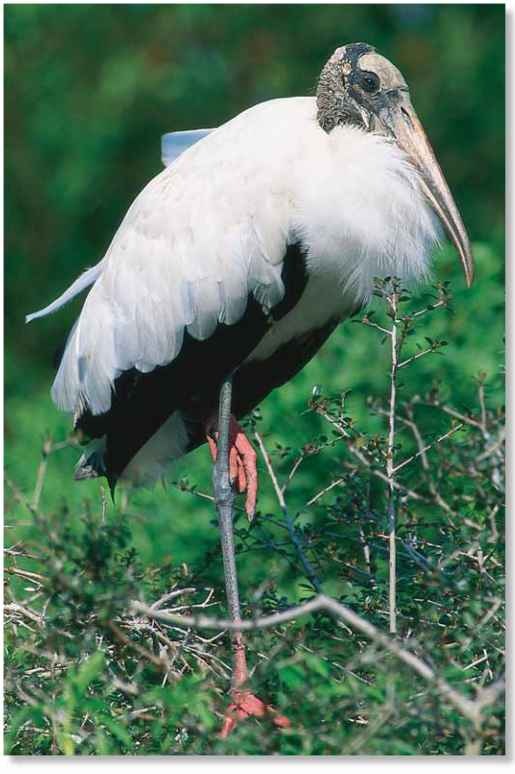ORDER
Ciconiiformes
FAMILY
Ciconiidae
GENUS & SPECIES
key features
• Strong, stout bill acts like a trap in the muddy water; snaps shut in only 25 milliseconds, one of the quickest reactions among vertebrates
• Nests in extremely large colonies that number in the thousands; up to 50 nests have been found in a single tree
• Breeds only when there is an abundance of food in the region
where in the world?
Found throughout the lower southeastern states of the U.S.; also found along both coasts of Mexico through Central and South America to northern Argentina
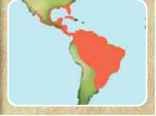
LIFECYCLE
Fish play a major role in a stork’s life; the bird flies to distant feeding sites in search of them, uses its sensitive bill to seize them and starts breeding when they are plentiful.
HABITAT
The American wood stork frequents freshwater wetlands, including inland marshes, swamps, lake-edge marshes and river bottoms, as well as mangrove swamps and lagoons.The water depth of these habitats fluctuates with the change of seasons, and in the dry season fish become highly concentrated in the pools and ponds remaining when water levels suddenly fall. This increase in the food supply triggers the start of the wood stork’s breeding season.To take advantage of food resources, the stork may exploit tidal waters along the coasts.
Standing room only A large colony of American wood storks basks in a crowded treetop.
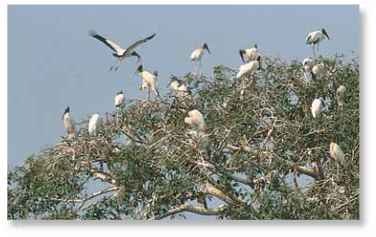
An adult wood stork requires about 18 oz. of fish per day, and a nestling requires about 36 lbs. of food from hatching to fledging. Thus, an average wood stork family requires about 440 lbs. of food per nesting season.
In Florida, wood storks fly on average 40 miles — but sometimes as much as 85 — from their home colony to entirely new foraging grounds. Storks tend to feed closer to the colony site when their young are small.
CONSERVATION
Though the American wood stork is not globally threatened, the population decreases in Florida have resulted in the stork being placed on the List of Endangered Species in the United States. Cutting of cypress stands and drainage of wetlands have affected North American populations.
BEHAVIOR
The wood stork is highly gregarious; it roosts and nests in colonies numbering in the thousands. Storks travel long distances from their colonies to forage, using warm air currents to soar to heights up to 5,000′, before descending with steep dives to a feeding site. The birds almost always feed in small groups of 2-6 birds.
During defense displays, storks shake their heads from side to side and grab at their opponent’s bill. Normally silent, vocalizations usually occur at the nest; adults hiss when relieving each other from incubation duties. Chicks are noisy, producing a high-pitched bray when begging and a repeated hiccough when distressed.To cool off, both adults and chicks urinate on their legs; when it evaporates, it cools the blood in the legs and, ultimately, the stork’s body.
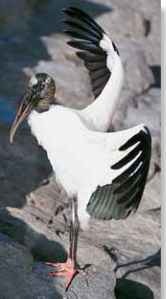
A Stretching out A tired wood stork rests its weary wings.
Branching out A stork carries material back to build its nest.
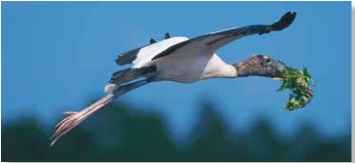
FOOD & FEEDING
The wood stork thrives on fish, but also eats small alligators and snakes, using its sensitive bill to locate prey. While standing in shallow, muddy water, the wood stork submerges its bill, opened about 2.5-3″. When the bill comes into contact with prey, it snaps shut in only 0.025 second, seizing its unsuspecting victim.The stork prefers fish that are over 1.5″; in the Florida Everglades, sunfish, flagfish and marsh killifish make up 72% of its diet. In drying ponds, there may be up to 8,000 fish per sq. yard, offering quick and easy meals for the stork and its young.
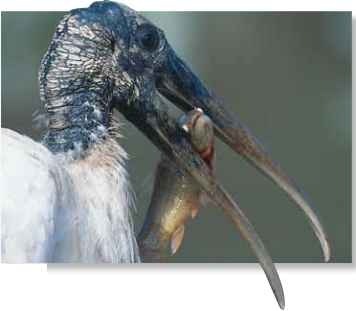
BREEDING
The stork begins breeding during the dry season when fish are plentiful. Males arrive first and move from tree to tree before settling on a nesting site. Females approach displaying males and choose a mate. The paired storks build a platform nest of sticks and vines. Nests are built up to 95′ high in cypress trees, measuring 17-35″ in diameter and 4-6″ deep. Stork colonies may include thousands of birds, with up to 50 nests in a tree.The female lays 2-5 eggs at 1-2 day intervals. Both sexes take turns incubating the eggs for about 29 days; when they hatch, the gray, down-covered nestlings weigh only 2.2 oz. each.The parents feed the young regurgitated food 4-15 times per day and, by the third week of life, the nestlings are almost half as large as the adults. The young fledge within 65 days and leave the nest soon after: They reach sexual maturity at 4 years of age, though nesting is usually not successful until 5 years.
Proud parents
A nestling rests under its parents’ watchful eyes.
A TOUCHING ENCOUNTER
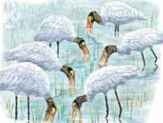
Wade and follow…
A group of wood storks walks slowly through shallow water, which is filled with aquatic vegetation and fish.
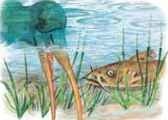
Close the gap…
A large catfish, one of the wood stork’s favorites, attempts to hide in the tangled plants as the stork submerges its bill in the water.
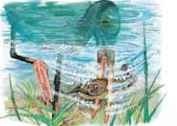
Quick snap…
The wood stork doesn’t need to see the fish: as soon as its bill touches the catfish, it snaps shut and traps the victim inside.
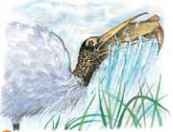
Short swallow
The catfish cannot escape; the wood stork raises its head above the water and swallows the fish whole in one gulp.
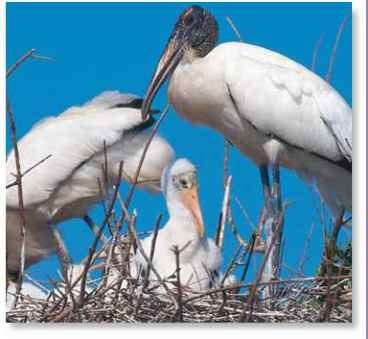
PROFILE
Wood Stork
The American wood stork has a stately stance and soars gracefully in flight when searching for nesting and feeding sites.
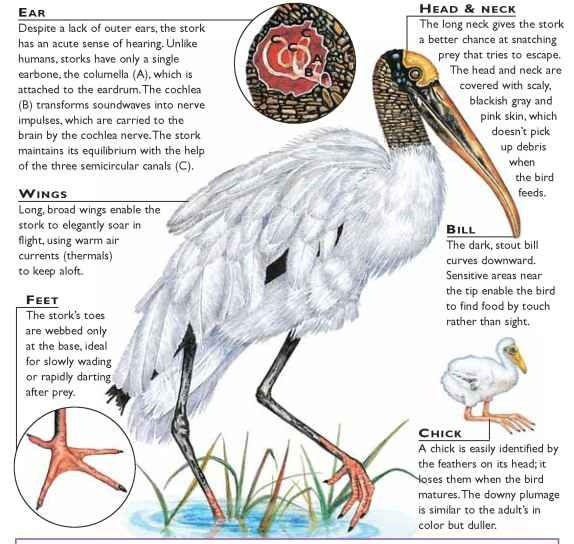
CREATURE COMPARISONS
The yellow-billed stork (Mycteria ibis) is found in Africa, south of the Sahara, far from the New World range of the wood stork. In both species the males are larger.Though both birds have white plumage, the yellow-billed stork’s yellow bill, red face and pink blush on the wing coverts easily distinguish it from the wood stork, though both species search for aquatic prey by touch. While the dry season signals the start of the wood stork’s breeding season, the yellow-billed stork waits for the rains. At 41″ long, the yellow-billed stork is similar in size to the American wood stork.
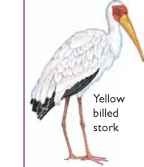
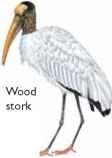
| VITAL | |
| STATISTICS | |
| Weight | Male 10 lbs.; female up to 6 lbs. |
| Length | 32.5-45″ |
| Wingspan | 59-65″ |
| Sexual Maturity | 4 years |
| Breeding Season Number of Eggs |
November -April |
| 2-5 | |
| Incubation Period | 28-32 days |
| Fledging Period | 55-65 days |
| Breeding Interval | 1 year |
| Typical Diet | Mainly fish; also small snakes and small alligators |
| Lifespan | Over 27 years |
RELATED SPECIES
• The American wood | stork is 1 of 4 species in the genus Mycteria, which includes the milky stork, M. cinerea, and painted stork, M. leucocephala. There are 19 species of stork in the family Ciconiidae, including the large marabou stork, Leptoptilos crumeniferus, which can grow up to 5′ tall. Storks join herons, ibises and spoonbills in the order Ciconiiformes.
